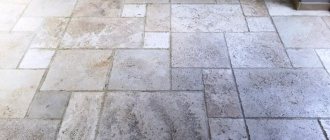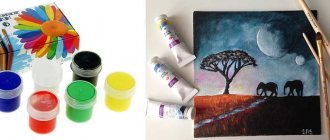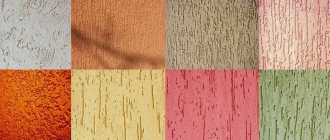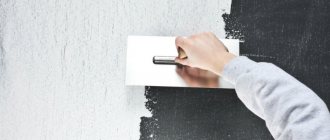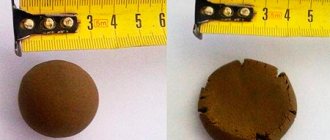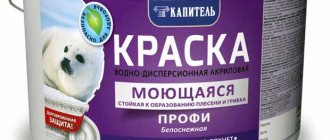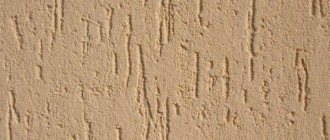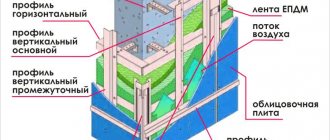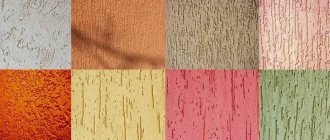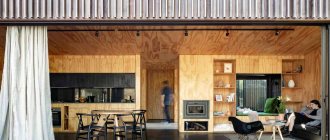Travertine is a rock, calcareous tuff, which is used in construction. This stone is also used for cladding houses and interior decoration. Currently, imitation of natural stone is widespread, for example, using colored cement mortar. In this article we will talk about decorative travertine plaster, its application technique and features.
Travertine – a genius of stylistic flexibility
It will harmoniously fit into almost any concept, no matter in what style the architect conceives the stylistic solution of the house. There are examples of travertine cottages in the high-tech style, in the direction of “eco-design”, classics, Western European trends, Scandinavian traditions and others. Stone combines organically with natural wood, glass, concrete, iron and steel. He has an amazing ability to harmoniously mix styles, the main thing is competent design work.
Travertine has less choice of colors and shades than marble - this is a well-known fact. But it is impossible to say that there are few of them. A stone supplier with extensive experience can further expand the selection through special techniques. Thus, longitudinal and transverse cuts of slabs give different patterns. And different directions of grinding allow you to change the shade even within the same color.
Travertine cladding is a classic solution. Granite blocks are more traditional, marble blocks are more common.
The stone has a livelier “character” than stately granite, and more “homely” than high-status marble.
Cladding the walls of the house with travertine
Our company carries out work of varying complexity on facade cladding with natural and artificial, as well as liquid travertine. The order is completed on time with a turnkey quality guarantee. You can find out the current cost from our managers. You can see travertine photos of houses on our website. The work is carried out by professionals, which allows you to achieve results of any complexity.
Installation of travertine has been carried out for a long time. This material is valued thanks to:
- Noble surface structure. The stone has a relief image that makes the wall original.
- Environmentally friendly material.
- A very durable stone due to its strong mineral structure.
- Economical option - does not require further cosmetic repairs.
- Excellent resistance to high and low temperatures and moisture.
- A variety of shapes, textures and colors. On sale you will find original solutions for facade cladding.
Properties of the stone
- Travertine is a soft rock. It lends itself easily to various types of processing. From it you can make amazingly beautiful stucco molding, bas-reliefs, pilasters, carved columns and other decorative elements.
- This stone is lighter than marble and granite. On the scale of a single plate, the difference is probably negligible. But if you calculate the load on the load-bearing capacity of the walls, it is felt.
- Environmental friendliness. Travertine, unlike artificial stone, does not emit harmful substances when the façade is heated by the sun, since it does not have polymer resins in its base. It is completely harmless to humans.
- Resistance to temperature changes. For travertine it is much higher than for marble. The stone easily tolerates Russian frosts, which are followed by thaws.
- Good heat and sound insulating properties. They are strengthened by such an installation method as a ventilated façade.
THERE IS A NUANCE!
“Travertine” and “liquid travertine” are different things. The first is a natural stone. The second is a type of decorative plaster with the addition of travertine chips. Accordingly, the listed properties apply only to whole breed.
Decorating the outside of the house with liquid travertine
Finishing the facade with liquid travertine is the choice of practical people who do not want to spend huge sums on natural rock. On sale you will find a special decorative mixture of acrylic, which is intended for internal and external cladding work.
When applying the material, the wall becomes like a stone one. Next, a level and a tool are used to apply an even pattern. As a result, we get a wall with symmetrical shapes, similar to natural travertine masonry. The surface fully corresponds to the natural characteristics of the stone.
Weak points of travertine
The porous structure of the stone absorbs soot and dirt from car exhaust gases. If the house is located near a highway or noisy streets, the performing company will need to competently select a method for processing slabs with cavity filling. If the contractor copes with this task with an “A+”, there will be no problem of premature contamination of the façade. And care will not require significant investment in time.
Another concern associated with the porous structure is that water will enter the gaps, freeze, expand and gradually destroy the stone. But this same property helps moisture quickly evaporate, the walls do not freeze and moisture does not accumulate between the adhesive solution and the slabs. Thanks to it, the rooms in the house “breathe”, the microclimate in the rooms is not disturbed and the “greenhouse” effect is not created. Using the example of St. Peter's Cathedral in Rome, we see that the impact of precipitation only makes the stone mass lighter, giving a noble vintage appearance and a certain historical high cost. There is no noticeable destruction of the structure. Even soft travertine is stronger than the hardest artificial stone!
How to care?
In order not to create problems for yourself in the future, it is better to immediately clad the house with slabs of dense varieties of travertine. Or purchase material treated with special compounds at the production stage. Closed pores will not allow dirt to spoil the facade. After several years of use, you can refresh the walls with a simple spray of water from a hose.
To care for the stone, do not use acids, such as vinegar or other aggressive liquids. If there is a need for more thorough care, you can purchase special solutions for travertine at hardware stores.
Travertine is an amazingly beautiful and elegant natural material. More and more buildings lined with it can be found in our cities and towns. With the right choice of stone, it will last for many years and will delight more than one generation of family with its appearance, without repairs or special care.
To see how the façade is covered with crushed travertine, see the following video.
How best to install a travertine façade
Two methods of laying slabs are suitable for this stone - seamless and with seams.
- Seamless. The slabs are placed joint-to-joint, creating the impression of a monolithic stone wall, which is important for houses of modern styles. The disadvantage of this method is the high rigidity of the structure. If the building has not yet shrunk, it is better to prefer the classic method.
- Suture. Joints of 2-3 mm will prevent the tiles from peeling off when the cottage deforms. They can be painted to match the stone or contrast it.
In terms of installation technology, two options are suitable.
- Wet facade. An extremely simple method is when travertine slabs are fixed to a leveled base with an adhesive composition. The solution fills the voids between the wall and the stone, so the fasteners are strong. But it is still more often used for small-sized tiles due to their weight.
- Ventilated facade. It differs fundamentally from the previous version in that it requires the installation of a metal sheathing. The stone is fixed to it, leaving an air gap between it and the wall.
Which method should I choose? The first option is more often used for residential buildings; it is simple, fast and relatively inexpensive. The second is common for cladding administrative and office buildings, commercial premises, and high-rise buildings. Requires certain qualifications from installers and is more expensive. But it allows you to perform high-quality noise and sound insulation along with finishing.
Stroytekhservice
Packaging: 0.5 l
Consumption: 200 g*1 sq.m of surface. Dilute 1:6 (0.5 liters of impregnation per 3 liters of water). Enough for 17 m2.
Impregnation R-08 is designed to protect decorative coatings on facades from dirt, dust, smog and other fat-containing substances, due to dense filling of micropores of the finishing surface, which does not allow dirt and grease to be absorbed into the surface.
After treatment with protective impregnation R-08, the surface can be periodically washed using machines under pressure at a distance of at least 80 cm. Application to the surface of the impregnation does not leave a film, does not fade over time and does not change the color of the coating. Provides additional waterproofing and strength.
Price: 350 rub.
PRIMER Rf-Dp (protective strengthening)
Packaging: 0.5 l.
Consumption: 80-120 g/sq.m. surface (depending on the absorbed surface). Dilute 1:2 (0.5 liters of impregnation per 1 liter of water).
Primer Rf-Dp - used for processing natural and artificial stone, concrete, various types of bricks, plaster, foam concrete and reinforced concrete products, asbestos-cement slabs.
The primer prevents the penetration of moisture into the structure of the material, the appearance of chips and contamination. Increases weather resistance and imparts water- and dirt-repellent properties.
Does not change the properties of the processed materials.
Properties: Non-toxic, fire and explosion-proof, does not contain solvents, practically odorless. Forms a strengthening, antibacterial, hydrophobic coating, which reliably blocks the penetration of moisture, bacteria, and various types of mold. Does not change the appearance and forms a vapor-permeable coating, extending the service life of the base.
Application conditions: Stir well before use. The temperature of the air and the treated surface is from +5C to +35C. Apply to a dry, clean, grease-free, hard, prepared surface with a brush, roller or spray. Complete drying of the primer - 24 hours.
Store at a temperature not lower than +5C.
Price: 350 rub.
Texture gun (hopper) is a pneumatic gun designed for decorative plastering work, spraying cement mixtures, marble chips, and liquid wallpaper.
Included:
• air gun;
• large plastic tank made of impact-resistant plastic - 6 liters;
• 3 nozzles for 4, 6, 8 mm;
• nipple and connecting nut (1/4 M thread).
Country of origin - China Type of pneumatic tool - Hopper Operating pressure - 3.5 bar Air consumption - 240 l/min
Price: 3000 rub.
Liquid travertine is used as a decorative, waterproofing, protective and strengthening coating. The material can be applied both to durable surfaces of plastered walls, stone, concrete slabs, and to surfaces subject to constant vibration, such as metal, plastic or other types of decorative panels.
APPLIED TO ANY MATERIAL The material can be applied both to durable surfaces of plastered walls, stone, concrete slabs, and to surfaces subject to constant vibration, such as metal, plastic or other types of decorative panels. In order to avoid overuse of material, it is recommended to apply the material to a leveled surface.
SURFACE REQUIREMENTS The surface on which the material must be applied must be durable, free of dust and absolutely dry. It is not allowed to use the material on surfaces that are stained with oils, grease and other substances that interfere with the necessary adhesion of the material to the surface. LAYER THICKNESS Each layer of applied material should not exceed 1.5 mm. The number of possible layers is unlimited. DRYING TIME The drying time of each applied layer must be at least 24 hours from the moment of application at a temperature not lower than 10 degrees.
ATTENTION:
Prohibited!
It is prohibited to add any foreign materials (lime, cement, gypsum, etc.) to the prepared material. It is prohibited to use material that has expired by mixing it with water or a new solution.
Instructions Leaflet
It is non-toxic and non-poisonous, does not emit harmful fumes when dried, and is absolutely environmentally friendly.
Withstands temperatures from -75 to +700 degrees Celsius, provided there are no mechanical impacts (impact, scratching, bending).
Does not allow dampness and moisture to reach the original surface, thereby protecting it from freezing and crumbling.
Characterized by high strength and resistance to mechanical stress.
Not affected by ultraviolet rays, weather conditions, or abrasion.
More than 30 years (PREMIUM)
The variety of textured effects for which liquid travertine is famous can bring to life various ideas in any type of interior, both classic and modern, when finishing walls and decorating them.
It is a breathable coating and has good vapor permeability.
Does not require periodic painting. Walls covered with liquid travertine can be washed with pressure washers. The use of additional care products is not provided.
Application conditions
Application temperature is from +5 to 35 C. Do not allow sand, stones or other substances to get into the solution, as well as dried particles of the solution if they remain on the walls of the container. In case of contact with eyes or skin of hands, rinse immediately with plenty of water.
Surface care
Decorative coating “Liquid Travertine” does not require additional maintenance. Walls on which this material is applied can be washed with pressure washers at a distance of at least 80 cm.
Storage conditions
Store in closed original packaging at temperatures from +5 to 35 C. The finished solution in unpacked containers must be used within 30 days. Freezing of the material and storage at temperatures below zero are not allowed.
